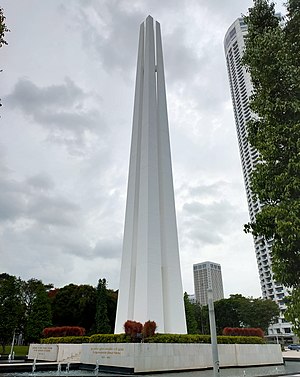| Sook Ching | |
|---|---|
| Part of the Japanese occupation of Singapore | |
 Civilian War Memorial, dedicated to the victims of Sook Ching and the wider occupation | |
| Location | Japanese-occupied Singapore[a] |
| Date | 18 February 1942 – 4 March 1942[b] (UTC+08:00) |
| Target | Identify and eliminate suspected "anti-Japanese elements"; with specific targets for Chinese Singaporeans or others perceived as a threat to the Japanese |
Attack type | Systematic purge and massacre |
| Deaths | 40,000 to 50,000 (consensus and retrospective analysis)[c][3] |
| Injured | Unknown |
| Perpetrators | Empire of Japan; Kempeitai within the Imperial Japanese Army
|
| History of Singapore |
|---|
 |
|
|
Sook Ching[d] was a mass killing that occurred from 18 February to 4 March 1942 in Singapore after it fell to the Japanese. It was a systematic purge and massacre of 'anti-Japanese' elements in Singapore, with the Singaporean Chinese particularly targeted by the Japanese military during the occupation. However, Japanese soldiers engaged in indiscriminate killing, and did not try to identify who was 'anti-Japanese.'
Singapore was a crucial strategic point in World War II. From 8 February to 15 February, the Japanese fought for control of the city. The combined British and Commonwealth forces surrendered in a stunning defeat to the outnumbered Japanese on 15 February which led to its fall. The loss of Singapore was and still is Britain's largest surrender in history.[4]
Three days later after the fall on 18 February, the occupying Japanese military began mass killings of a wide range of "undesirables", who were mostly ethnic Chinese, influenced by the events of the Second Sino-Japanese War that was raging simultaneously as far back as 1937. The operation was overseen by the Imperial Japanese Army's Kempeitai, its secret police. Along with Singapore, the Sook Ching was subsequently also extended to include the Chinese population in Malaya, which was also under occupation by the Japanese. Concurrently, non-Chinese individuals were also not completely spared in other parts of Asia under Japanese occupation; the Japanese had also killed at least 150,000 Tamil Indians as well as an additional 90,000 civilians in Burma and Thailand, many of which were also forced to work on the Siam–Burma Railway, infamously known as the Death Railway.
The aim for such a purge was to intimidate the Chinese community, which was considered by the Japanese to be potentially the main centre of resistance to Japanese aims of territorial expansion throughout the Asia-Pacific. The Japanese had also thought of it as a "revenge" for their perceived anti-Japanese activity in the Sinophone regions, such as procuring financial aid for China after the Japanese invasion of Manchuria and during the Second Sino-Japanese War. As a consequence, Sook Ching was aimed primarily at Chinese political and social activists, volunteers fighting on the side of the Allies,[e] as well as representatives of Chinese triads. In practice, however, the arrests and executions were carried out by the Japanese in a completely arbitrary manner, with many civilians randomly killed in summary executions even if they took no part in any organised resistance.[1]
After the war, the Japanese authorities acknowledged that the massacre took place, but disagreed about the number of deaths that Japan had caused. Japan alleged that no more "than 6,000 deaths" had occurred, while Singapore's first prime minister Lee Kuan Yew, who was himself almost a victim to Sook Ching, stated that verifiable numbers would put it at "about 70,000", including the figures in Malaya.[5] When mass graves were discovered in 1962, Singaporeans heavily lobbied for their government to demand compensation as well as an official apology from the Japanese government.[6] On 25 October 1966, the Japanese government ultimately agreed to reimburse S$50 million in reparations, half of which constituting as a grant and the rest as a loan.[6] However, the wording used for this reimbursement was classified as a "gesture of atonement", with words such as "damages" or "reparations" being avoided by the Japanese. Furthermore, the Japanese government continued to refuse to accept legal responsibility for the massacre, which would include carrying out an official investigation or inquiry of the deaths.[7] No official apology was made.[7] Remains of Sook Ching victims would subsequently continue to be unearthed by Singaporeans for decades after the massacre. In 1963, the Civilian War Memorial was constructed in memory of the civilians killed during the occupation, including Sook Ching. Remains belonging to some of the victims were also placed in a tomb under the memorial. In 1992, the various Sook Ching massacre sites around the country such as Changi Beach, Katong, Punggol Point, Tanah Merah and Sentosa were designated with historic plaque markers as heritage sites by the Singaporean government's National Heritage Board, to commemorate the 50th anniversary of the occupation.
Cite error: There are <ref group=lower-alpha> tags or {{efn}} templates on this page, but the references will not show without a {{reflist|group=lower-alpha}} template or {{notelist}} template (see the help page).
- ^ a b "Operation Sook Ching is carried out - Singapore History". eresources.nlb.gov.sg. National Library Board. Retrieved 18 February 2022.
- ^ Lee, Geok Boi (2005). The Syonan Years: Singapore Under Japanese Rule, 1942-1945. Singapore: National Archives of Singapore. ISBN 9810542909. Retrieved 18 February 2022.
- ^ Rigg, Bryan Mark (2024). Japan's Holocaust: History of Imperial Japan's Mass Murder and Rape During World War II. Knox Press. pp. 98–99. ISBN 9781637586884.
- ^ Corrigan 2010, p. 280.
- ^ Chew, Cassandra (29 June 2014). "The Rickshaw puller who saved Lee Kuan Yew |". www.straitstimes.com. The Straits Times. Archived from the original on 18 February 2022. Retrieved 18 February 2022.
- ^ a b Ho, Stephanie (17 June 2013). "Operation Sook Ching". Singapore Infopedia. National Library Board Singapore 2013. Retrieved 18 June 2021.
- ^ a b Hayashi Hirofumi (13 July 2009). "The Battle of Singapore, the Massacre of Chinese and Understanding of the Issue in Postwar Japan". The Asia-Pacific Journal. 7 (28). Retrieved 10 May 2015.